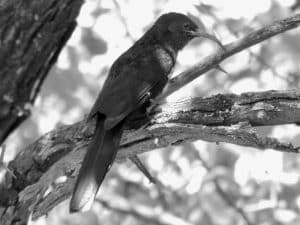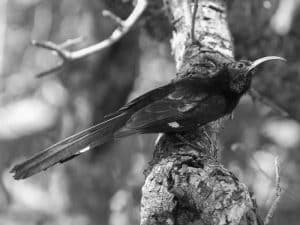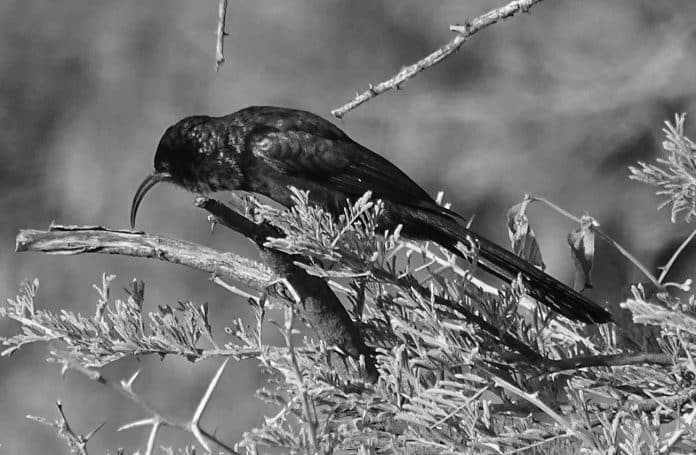Introduction to the common scimitarbill
Welcome to the enchanting world of the common scimitarbill, a captivating bird that graces the savannas of Tanzania with its presence. The common scimitarbill in Tanzania, scientifically known as Rhinopomastus cyanomelas, is a species of bird that belongs to the family of wood hoopoes. With its distinct features and melodic calls, the common scimitarbill has become a beloved resident of the Tanzanian wilderness, captivating the hearts of bird enthusiasts and nature lovers alike.

The common scimitarbill is renowned for its striking appearance and unique vocalizations, which make it a fascinating subject for birdwatchers and wildlife photographers. Its long, curved beak and vibrant plumage set it apart from other avian species, while its agile movements and sociable nature add to its allure. As we delve deeper into the world of the common scimitarbill, you will gain a deeper understanding of its habitat, behavior, and cultural significance, providing you with a comprehensive insight into this remarkable bird.
Habitat and distribution of the common scimitarbill in Tanzania
The common scimitarbill is predominantly found in the eastern and southern regions of Tanzania, where it inhabits a variety of habitats ranging from open woodlands and savannas to riverine forests. This adaptable species thrives in environments characterized by scattered trees and shrubs, utilizing its keen foraging skills to seek out insects, small reptiles, and other invertebrates. Its distribution within Tanzania encompasses national parks such as the Serengeti, Tarangire, and Ruaha, where it adds a touch of vibrancy to the diverse ecosystem.
In addition to its presence in Tanzania, the common scimitarbill also extends its range into neighboring countries such as Kenya, Zambia, and Malawi. Its ability to thrive in different ecological settings underscores its resilience and adaptability, making it a testament to the rich biodiversity of the East African region. As you explore the habitat and distribution of the common scimitarbill, you will gain a profound appreciation for the interconnectedness of this species with the landscapes it calls home.
Physical characteristics and behavior of the common scimitarbill
The common scimitarbill is distinguished by its striking physical attributes, including a long, downward-curved beak that aids in probing for prey in the leaf litter and soil. Its predominantly black plumage is accentuated by a white belly and bold streaks of blue on its wings, adding a splash of color to its appearance. This avian marvel boasts a slender frame and agile movements, allowing it to navigate through the intricate foliage of its habitat with grace and precision.
In terms of behavior, the common scimitarbill is known for its gregarious nature, often forming small flocks as it forages for food and communicates through a series of melodious calls. Its adeptness at capturing insects on the wing showcases its hunting prowess, while its communal roosting behavior highlights its social bonds within the group. By delving into the physical characteristics and behavior of the common scimitarbill, you will gain a deeper insight into the intricacies of this avian marvel and the role it plays in the Tanzanian ecosystem.
Importance of the common scimitarbill in the ecosystem
The common scimitarbill serves as a vital component of the Tanzanian ecosystem, contributing to the balance of predator-prey dynamics and the dispersion of seeds through its foraging activities. As an insectivorous species, it plays a crucial role in regulating insect populations, thereby mitigating potential agricultural pests and maintaining the ecological equilibrium. Furthermore, its presence in the wild serves as an indicator of habitat health, reflecting the integrity of the landscapes it inhabits.
Beyond its ecological significance, the common scimitarbill also contributes to the cultural and aesthetic value of the Tanzanian wilderness. Its enchanting calls and vibrant plumage add a touch of splendor to the savannas, captivating the hearts of onlookers and inspiring a sense of wonder and appreciation for the natural world. By recognizing the importance of the common scimitarbill in the ecosystem, we can foster a deeper sense of stewardship and conservation for the habitats it depends on.
Conservation status of the common scimitarbill in Tanzania

The conservation status of the common scimitarbill in Tanzania is a topic of paramount importance, given the various threats facing its population. Habitat loss, primarily due to land conversion for agriculture and urbanization, poses a significant risk to the species, disrupting its nesting sites and foraging grounds. Additionally, factors such as climate change and human-wildlife conflict further exacerbate the challenges faced by the common scimitarbill, necessitating concerted efforts to safeguard its future.
To address these conservation concerns, organizations and conservationists in Tanzania have been actively involved in habitat restoration, community engagement, and research initiatives aimed at understanding the ecological needs of the common scimitarbill. By raising awareness about the plight of this captivating species and implementing targeted conservation strategies, there is hope for securing its presence in the Tanzanian wilderness for generations to come.
Best places to spot the common scimitarbill in Tanzania
For avid birdwatchers and nature enthusiasts, Tanzania offers a plethora of prime locations to spot the common scimitarbill in its natural habitat. National parks such as the Serengeti, renowned for its expansive grasslands and diverse wildlife, provide ideal opportunities to observe these captivating birds as they engage in their daily activities. The Tarangire National Park, characterized by its ancient baobab trees and meandering riverine ecosystems, also serves as a favored setting for encountering the common scimitarbill.
In addition to these iconic destinations, the Selous Game Reserve and Ruaha National Park offer immersive experiences for birdwatching enthusiasts, with their mosaic of habitats and rich avian diversity. Whether embarking on a guided safari or a self-guided exploration, visitors to Tanzania can revel in the chance to witness the common scimitarbill in its natural splendor, creating cherished memories amidst the breathtaking landscapes of the Tanzanian wilderness.
Birdwatching tips for observing the common scimitarbill
When venturing into the Tanzanian savannas in search of the common scimitarbill, it is essential to equip yourself with the necessary knowledge and tools to enhance your birdwatching experience. Patience and attentiveness are key virtues when observing these elusive birds, as their agile movements and cryptic behavior may require a keen eye and a quiet demeanor. By familiarizing yourself with their vocalizations and preferred habitats, you can increase your chances of encountering the common scimitarbill in the wild.
In addition to honing your observational skills, having a pair of binoculars and a camera with a telephoto lens can elevate your birdwatching expedition, allowing you to appreciate the intricate details of the common scimitarbill’s plumage and behavior while preserving cherished moments through photography. Whether embarking on a dawn safari or a leisurely stroll through the woodlands, the art of birdwatching unveils a world of wonder and discovery, inviting you to immerse yourself in the natural splendor of Tanzania.
Capturing the beauty of the common scimitarbill through photography
With its vibrant plumage and captivating demeanor, the common scimitarbill presents a compelling subject for wildlife photography enthusiasts seeking to immortalize its beauty through visual storytelling. As you embark on a photographic journey to capture the essence of this avian marvel, consider the interplay of light and shadow amidst the Tanzanian landscapes, accentuating the intricate patterns and hues of the common scimitarbill’s plumage. Patience and keen observation are essential as you await the opportune moments to frame the perfect composition, allowing the bird’s natural behavior to unfold before your lens.
Incorporating elements of the surrounding environment, such as native flora and the expansive savannas, can provide a contextual backdrop for your photographs, offering a sense of narrative and place to your visual storytelling. Whether through close-up portraits or sweeping vistas that encompass the common scimitarbill in its habitat, your photographic endeavors can serve as a testament to the enduring allure of Tanzania’s avian treasures and the timeless beauty of the natural world.
The role of the common scimitarbill in Tanzanian culture and folklore

The common scimitarbill holds a revered place in Tanzanian culture and folklore, its presence intertwined with stories and traditions passed down through generations. In various local communities, the bird’s distinctive calls and striking appearance have inspired tales of resilience, adaptability, and the interconnectedness of all living beings. Its graceful presence in the savannas is often regarded as a symbol of harmony and vitality, reflecting the enduring spirit of the natural world.
Furthermore, the common scimitarbill’s role in local folklore serves as a testament to the enduring bond between humans and wildlife, fostering a sense of reverence and symbiosis with the natural environment. Through traditional songs, dances, and oral traditions, the bird’s essence is celebrated as a reflection of the cultural tapestry that enriches the Tanzanian heritage, imparting a profound sense of connection and belonging to the land.
Conclusion
In conclusion, the common scimitarbill stands as a symbol of resilience and natural splendor in the savannas of Tanzania, captivating the hearts of all who encounter its melodic calls and vibrant presence. From its distinctive physical characteristics and gregarious behavior to its ecological significance and cultural resonance, the common scimitarbill embodies the rich tapestry of the Tanzanian wilderness, inviting us to appreciate and safeguard the wonders of the natural world.
As we immerse ourselves in the captivating realm of the common scimitarbill, let us cherish the interconnectedness of all living beings and strive to uphold the conservation efforts that safeguard its future in the wild. Whether through birdwatching expeditions, photography endeavors, or the sharing of timeless stories, the common scimitarbill serves as a beacon of inspiration, serenading the savanna and enriching the landscapes it calls home.
Now, as you embark on your journey to witness the allure of the common scimitarbill in Tanzania, may your experiences be filled with wonder and appreciation for the natural world, fostering a sense of stewardship and admiration for the avian treasures that grace the East African wilderness.

































